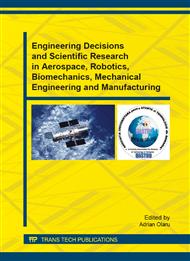[1]
Y. H. Chen, Y. N. Hu, Implementation of a Robot System for Sculptured Surface Cutting. Part I Rough machining. Int. J. Adv. Manuf. Techn., vol. 15, (1999), pp.624-629.
DOI: 10.1007/s001700050111
Google Scholar
[2]
Y. N. Hu, Y. H. Chen, Implementation of a Robot System for Sculptured Surface Cutting. Part II. Finish machining. Int. J. Adv. Manuf. Techn., vol. 15, (1999), pp.630-639.
DOI: 10.1007/s001700050112
Google Scholar
[3]
H. Latos, T. Mikolajczyk, Surface Shaping with Industrial Robot. OPTIROB'2006, Predeal, Romania, University POLITEHNICA, of Bucharest, (2006), pp.265-269.
Google Scholar
[4]
T. Mikolajczyk, Manufacturing Using Robot. Advanced Materials Research, vol. 463-464, (2012) pp.1643-1646.
DOI: 10.4028/www.scientific.net/amr.463-464.1643
Google Scholar
[5]
T. Mikolajczyk, Robot Application to Surface Finishing, Journal of Polish CIMAC, Vol. 5, Nr 3, (2010), pp.107-112.
Google Scholar
[6]
T. Mikolajczyk, Indication of Machining Area with the Robot's Camera Using, Applied Mechanics and Materials, vol. 282 , (2013), pp.146-151.
DOI: 10.4028/www.scientific.net/amm.282.146
Google Scholar
[7]
T. Mikolajczyk, Robot-Turner. Advanced Materials Research, vol. 463-464, (2012), pp.1682-1685.
DOI: 10.4028/www.scientific.net/amr.463-464.1682
Google Scholar
[8]
T. Mikolajczyk, System to Surface Control in Robot Machining. Advanced Materials Research, vol. 463-464 (2012), pp.708-711.
DOI: 10.4028/www.scientific.net/amr.463-464.708
Google Scholar
[9]
T. Mikolajczyk, Videooptical Surface Shape and Integrity Estimation in Robots Machining, Applied Mechanics and Materials, vol. 332, (2013), pp.431-436.
DOI: 10.4028/www.scientific.net/amm.332.270
Google Scholar
[10]
T. Mikolajczyk, P. Wasiak, Machining with Image Recognition Using Industrial Robot. Applied Mechanics and Materials, vol. 186, (2012), pp.50-57.
DOI: 10.4028/www.scientific.net/amm.186.50
Google Scholar
[11]
H. Latos, T. Mikolajczyk, Virtual Aid to Design of Geometric and Kinematics Flexible Tools. XII Workshop on Superv. and Diagn. of Mach. Sys. Virtual Manuf., Karpacz, Poland, (2001), pp.145-152.
Google Scholar
[12]
F. Ribeiro, J. Norrish, Case Study of Rapid Prototyping using Robot Welding. http: /repositorium. sdum. uminho. pt/bitstream/1822/3083/1/12%20PROBOT~2. pdf.
Google Scholar
[13]
T. Mikolajczyk, J. Lewandowski, Kształtowanie przyrostowe z zastosowaniem robota przemysłowego. (Rapid Prototyping Using Industrial Robot. ) Inżynieria i Aparatura Chemiczna, nr 3, (2011), pp.51-57, (in polish).
Google Scholar
[14]
Giant Robot Prints Chairs from Ground-Up Refrigerators [Video] http: /www. fastcodesign. com/1662793/giant-robot-prints-chairs-from-ground-up-refrigerators-video?partner=co_newsletter.
Google Scholar
[15]
T. Mikołajczyk, P. Milko, Shaping of Polystyrene Foam Products with Industrial Robots. OPTIROB, Predeal, University POLITECHNICA, of Bucharest, (2006), pp.261-264.
Google Scholar
[16]
A. Pusthuma, Development of a Novel Robotically Effected Plastic Foam Sculpting System for Rapid Prototyping and Manufacturing http: /ir. canterbury. ac. nz/handle/10092/1209.
Google Scholar
[17]
I. Horváth, S. Joris, M. Vergeest, I. Juhász, Finding the Shape of a Flexible Blade for Free-Form Layered Manufacturing of Plastic Foam Objects http: /citeseerx. ist. psu. edu/viewdoc/download?doi=10. 1. 1. 27. 4242&rep=rep1&type=pdf19.
DOI: 10.1115/detc98/dfm-5752
Google Scholar
[18]
J. Zhu, R. Tanaka, T. Tanaka, Y. Saito, An 8-Axis Robot Based Rough Cutting System for Surface Sculpturing, The 11th International Conference on Precision Engineering (ICPE), Tokyo, Japan, No. 16-18, (2006-8), pp.139-144.
DOI: 10.1007/1-84628-559-3_23
Google Scholar
[19]
H. Latos: Zastosowanie ostrzy o prostoliniowych krawedziach do obrobki powierzchni, (Implementation of Straight Cutting Edges for Surface Machining). Zeszyty naukowe Akademii Techniczno-Rolniczej nr 51, Mechanika 19, Bydgoszcz 1978, (in polish).
Google Scholar
[20]
J. Bronsztein, K. Semendaiev K., Matematyka. Poradnik Encyklopedyczny. (Mathematics. Encyclopedic Handbook), PWN Warszawa, wyd. XX, 2004 (in polish).
Google Scholar
[21]
H. Latos: Elastycznosc geometryczno-kinematyczna narzedzi skrawajacych, (Geometrics and Kinematics Flexibility of Cutting Tools) . Wydawnictwo Uczelniane Akademii Techniczno-Rolniczej, Bydgoszcz, 1997 (in polish).
Google Scholar
[22]
T. Mikolajczyk, L. Kamieniecki, PC Controlled Turning Tool. Applied Mechanics and Materials, vol. 325-326, (2013), pp.1110-1114.
DOI: 10.4028/www.scientific.net/amm.325-326.1110
Google Scholar
[23]
T. Mikolajczyk, Modernisation of IRb60 Industrial Robot Steering System. OPTIROB'2007, Predeal, Romania, University POLITEHNICA, of Bucharest, (2007), pp.149-152.
Google Scholar


